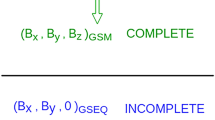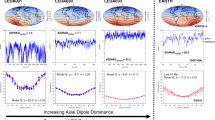Abstract
WE outline here some of the implications of the latest in a series of models of the Earth' magnetic field derived in association with the World Magnetic Charts published by the British Hydrographic Office. The model, details of which are published elsewhere1, is defined by spherical harmonic coefficients representing the internal part of the magnetic field (to twelfth order and degree; 168 coefficients), its secular variation (to eighth order and degree; 80 coefficients), and its secular acceleration (the 26 most significant coefficients) at epoch 1975.0. Because of the greatly improved distribution, accuracy and quantity of data incorporated in the analysis, we believe that this model, particularly with regard to the secular variation, provides a significantly better representation of the Earth's magnetic field than any previous model. It is of interest to compare some of the parameters derived from this model with the trends shown by its predecessors.
This is a preview of subscription content, access via your institution
Access options
Subscribe to this journal
Receive 51 print issues and online access
$199.00 per year
only $3.90 per issue
Buy this article
- Purchase on Springer Link
- Instant access to full article PDF
Prices may be subject to local taxes which are calculated during checkout
Similar content being viewed by others
References
Barraclough, D. R., Harwood, J. M., Leaton, B. R., and Malin, S. R. C., Geophys. J. R. astr. Soc., 43, 645 (1975).
Malin, S. R. C., Geophys. J. R. astr. Soc., 17, 415 (1969).
Leaton, B. R., and Malin, S. R. C., Nature, 213, 1110 (1967).
Malin, S. R. C., and Clark, A. D., Geophys. J. R. astr. Soc., 36, 11 (1974).
Adam, N. V., Baranova, T. N., Ben'kova, N. P., and Cherevko, T. N., Geomagn. Aeron., 10, 1068 (English edition: page 854) (1970).
Dawson, E., and Loomer, E. I., Publs Dom. Obs., 28, 195 (1963).
Halley, E., Phil. Trans. R. Soc., 17, 563 (1693).
Richmond, A. D., J. geophys. Res., 74, 3013 (1969).
Yukutake, T., Bull. Earthq. Res. Inst. Tokyo Univ., 40, 1 (1962).
Vestine, E. H., and Kahle, A. B., Geophys. J. R. astr. Soc., 15, 29 (1968).
James, R. W., Comments Earth Sci. Geophys., 2, 28 (1971).
Malin, S. R. C., and Saunders, I., Nature, 245, 25 (1973).
Malin, S. R. C., and Saunders, I., Nature, 248, 403 (1974).
Author information
Authors and Affiliations
Rights and permissions
About this article
Cite this article
HARWOOD, J., MALIN, S. Present trends in the Earth's magnetic field. Nature 259, 469–471 (1976). https://doi.org/10.1038/259469a0
Received:
Accepted:
Issue Date:
DOI: https://doi.org/10.1038/259469a0
This article is cited by
-
Geomagnetic secular variation impulses
Nature (1984)
-
Decade fluctuations in geomagnetic westward drift and Earth rotation
Nature (1981)
-
Archaeomagnetic secular variation record of Mount Vesuvius
Nature (1981)
Comments
By submitting a comment you agree to abide by our Terms and Community Guidelines. If you find something abusive or that does not comply with our terms or guidelines please flag it as inappropriate.



